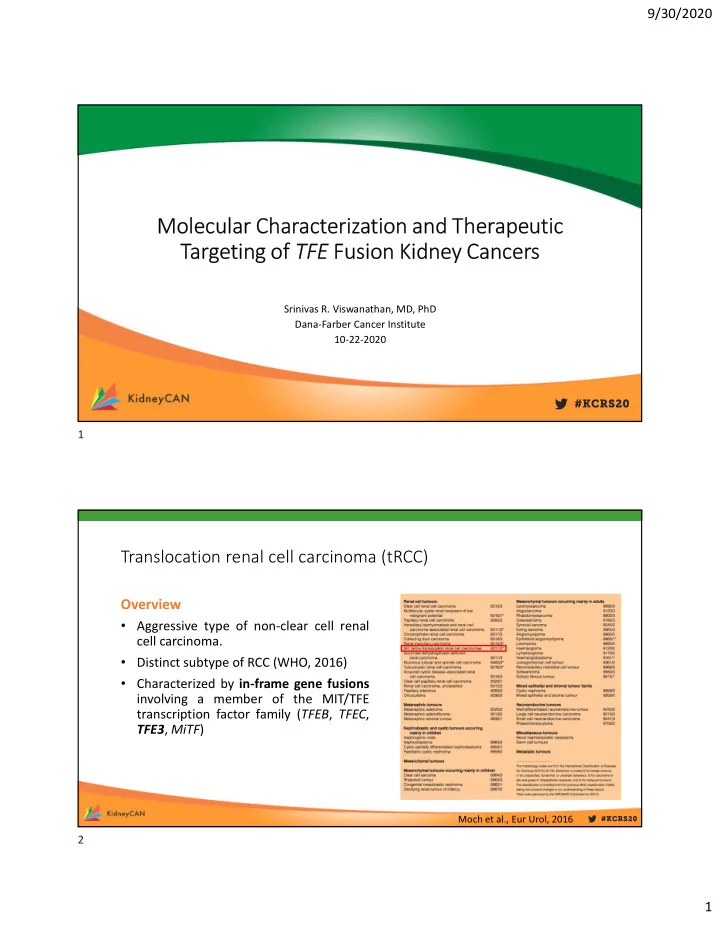

9/30/2020 Molecular Characterization and Therapeutic Targeting of TFE Fusion Kidney Cancers Srinivas R. Viswanathan, MD, PhD Dana-Farber Cancer Institute 10-22-2020 1 Translocation renal cell carcinoma (tRCC) Overview • Aggressive type of non-clear cell renal cell carcinoma. • Distinct subtype of RCC (WHO, 2016) • Characterized by in-frame gene fusions involving a member of the MIT/TFE transcription factor family ( TFEB , TFEC , TFE3 , MiTF ) Moch et al., Eur Urol, 2016 2 1
9/30/2020 Translocation renal cell carcinoma (tRCC) Epidemiological/Clinical Features • 30-40% of pediatric RCC; 1-5% of adult RCC • Incidence in adults may be underestimated due to morphological overlap with other RCC subtypes • Median age ~ 40 (for both TFE3 and TFEB tRCC) • Female to male predominance • Associated with prior exposure to chemotherapy (secondary malignancy) • Lymph node metastases predominate Caliò et al., Cancers, 2019 3 Translocation renal cell carcinoma (tRCC) Clear cell pattern Pathological Features • Can mimic other common subtypes of RCC • Many different architectural and cytologic features possible • Papillary architecture with epithelioid clear Papillary pattern cells and abundant psammoma bodies most distinctive Cystic pattern Caliò et al., Cancers, 2019; Crumley et al., WJCC, 2013 4 2
9/30/2020 Translocation renal cell carcinoma (tRCC) Diagnosis • PAX2/8+CK7- • Melanocyte markers may be positive (Melan-A; HMB45) • Cathepsin K positive in ~50% • IHC for TFE3 protein can detect overexpressed nuclear TFE3 due to translocation but poor PPV. • Caveats: false positives from detection of native TFE3; detection is highly fixation-dependent • Break-apart FISH highly sensitive and specific • Caveat: split signals can be very close in cases of fusions arising via intrachromosomal inversion Green et al., AJSP, 2013; Crumley et al., WJCC, 2013 5 Structure of TFE Fusions TFE3 Fusion Structure TFE3 fusions • In-frame fusions that produce a chimeric TFE3 protein product • C-terminal exons of TFE3 (bHLH-LZ +/- AD) and Fusion N-terminal exons from one of several fusion partner partners TFEB fusions • Typically MALAT1-TFEB gene fusions with breakpoints before the start codon in TFEB TFE3 fusion • Retention of complete TFEB coding sequence Shatha AbuHammad; Kauffman et al., Nat Rev Urol., 2014 6 3
9/30/2020 TFE3 fusion partners • > 15 different TFE3 fusion partners have been ASPL described CLTC DVL2 • Most common: EWSR1 Domains FUBP1 • PRCC-TFE3: FUBP2 RRM KH t(X;1)(p11.2;q21) LUC7L3 GRIPAP1 PLD RGG MATR3 • ASPL-TFE3: MED15 t(X;17)(11.2;q25) NONO • SFPQ-TFE3: PARP14 PRCC t(X;1)(p11.2;p34) RBM10 • Many partners are RNA RBMX SETD1B binding proteins or SFPQ nuclear proteins U2FA2 Shatha AbuHammad 7 TFE3 fusion partners and the mechanisms that produce fusions • TFE3 fusions usually arise via balanced (reciprocal) translocation chrX chr17 • Both intra- and inter- chromomal rearrangement PRCC-TFE3 fusion in a male partners chr1 chrX 3 2 1 0 150 155 160 165 40 45 50 55 • Some chromosomal locations Genome Coordinate (Mb) harbor multiple TFE3 partners Argani et al., Am. J. Path., 2001; Cheng-Zhong Zhang 8 4
9/30/2020 The molecular landscape of tRCC • tRCC cohorts have been profiled by targeted panel/WES • MIT/TFE fusions are universal • Few other recurrent alterations • Mutations in chromatin remodeling genes • TERT promoter mutations • Arm-level copy number events relatively From Marcon et al., CCR, 2020 common and may be associated with disease aggressiveness. Malouf et al., CCR, 2013/14; Marcon et al., CCR, 2020 9 Prior RCC sequencing studies contain tRCC samples • Several prior large-scale ccRCC, pRCC, chRCC sequencing efforts each contain a small number of “mis-classified” tRCCs • Pooling tRCC data across these large datasets may provide increased power to more precisely define the molecular landscape of tRCC Ziad Bakouny; Nebiyou Metaferia; Toni Choueiri 10 5
9/30/2020 Prior RCC sequencing studies contain tRCC samples • The transcriptional program in tRCC is quite distinct from that of other RCC subtypes Ziad Bakouny; Nebiyou Metaferia; Toni Choueiri 11 tRCC has distinct clinical features from other RCC subtypes (localized & metastatic) Variable N (%) Institutional Cohort Sex Male 24 (36) Female 42 (64) Age at diagnosis, median (range) 48 (15-89) Initial disease extent OS Localized 42 (64) Subsequent relapse 14 (33) Metastatic (de novo) 24 (36) History of childhood cancer 1 (2) Prior chemotherapy 4 (6) Variable N (%) Sex Time Male 29 (51) (metastatic) Female 28 (49) • Female predominance (localized dz) De novo metastatic disease IMDC Male 18 (45) • Subset have exposure to prior to Female 22 (55) Age at diagnosis, median (range) 42 (15-78) chemotherapy Prior chemotherapy 4 (7) IMDC risk at 1 st line therapy Good 4 (7) • OS poor compared with ccRCC and Intermediate/Poor 53 (93) chRCC Praful Ravi; Ziad Bakouny; Toni Choueiri; IMDC 12 6
9/30/2020 Selectively targeting tRCC • TFE3 fusions are a selective vulnerability of tRCC cells ccRCC tRCC 13 Potential therapeutic targets in tRCC Theraputic Target Reference RET Baba, M. et al. Mol Cancer Res , 201 Tsuda, M. et al. Cancer research, 2007 MET Kobos, R. et al. The Journal of pathology , 2013 NAMPT Kobos, R. et al. The Journal of pathology , 2013 nicotinamide phosphoribosyltransferase WNT Calcagni, A. et al. Elife , 2016 mTORC1/2 Kauffman, E. C. et al. BMC Cancer , 2019 IRS-1/PI3K/AKT/mTOR Damayanti et al. CCR, 2018 14 7
9/30/2020 Conclusions • tRCC is clinically aggressive compared with other RCC subtypes and further research into this subtype of RCC remains an unmet need • Molecular landscape of tRCC is emerging • Several molecular pathways downstream of MIT/TFE fusions have been nominated as therapeutic targets 15 Acknowledgements Ziad Bakouny Gregory Brunette Viswanathan Lab Praful Ravi Tarek Bismar Shatha AbuHammad Jiao Li Thomas Denize Shaan Dudani Vidya Sethunath Jack Steinharter Daniel Heng Emma Garner Gabrielle Bouchard Sabina Signoretti Nebiyou Metaferia Catherine Curran Cheng-Zhong Zhang Stephen Tang Jinyu Wang Toni Choueiri Richard Tourdot IMDC 16 8
Recommend
More recommend